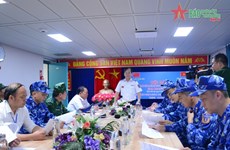National Geographic Society to denote “Hoang Sa” on maps
The National Geographic Society (NGS) of the US will revise the naming
conventions of the Hoang Sa (Paracel) archipelago in its maps, according
to the
society’s latest statement issued on March 25.
The National Geographic Society (NGS) of the US will revise the naming
conventions of the Hoang Sa (Paracel) archipelago in its maps, according to the
society’s latest statement issued on March 25.
The NGS says on larger-scale regional, continental and sectional maps, the NGS will use the conventional name – Paracel Islands with possession qualifier -- “occupied by China in 1974, which calls them Xisha Qundao; claimed by Vietnam , which calls them Hoang Sa”.
For smaller-scale world maps, the NGS will use the conventional name of Paracel Islands and omit possession label, the statement said, adding that the new naming conventions had been adopted following the NGS’s Map Policy Committee’s recent discussions on the matter.
The committee said based on the best information and research available, it wants to make “independent judgments about future changes or clarifications on its maps, as well as to correct any errors.”
The NGS affirmed that these conventions will apply on future printings of its maps and will be reflected online in short order.
However, a world map posted on the site still denotes “Paracel Is” with the word “ China ” in red letters below.
Recently, the NGS has posted the online world map on which it designates the Chinese name of “Xisha Qundao” with the word “ China ” in the Hoang Sa (Paracel) archipelago of Vietnam at http://www.natgeomaps.com , prompting waves of both official and public protest.
On March 13, Vietnamese foreign ministry’s spokesperson Nguyen Phuong Nga claimed that “the world map denoting ‘Paracel Is. China ’ published by the National Geographic is wrong” and requested that the society correct this mistake.
The Vietnamese spokeswoman again reiterated that “ Vietnam has indisputable sovereignty over the Hoang Sa and Truong Sa archipelagoes.”
On March 16, the NGS admitted in a press release that denoting the Hoang Sa archipelago with the Chinese name and the word “ China ” without further explanation can be misleading or misinterpreted./.
The NGS says on larger-scale regional, continental and sectional maps, the NGS will use the conventional name – Paracel Islands with possession qualifier -- “occupied by China in 1974, which calls them Xisha Qundao; claimed by Vietnam , which calls them Hoang Sa”.
For smaller-scale world maps, the NGS will use the conventional name of Paracel Islands and omit possession label, the statement said, adding that the new naming conventions had been adopted following the NGS’s Map Policy Committee’s recent discussions on the matter.
The committee said based on the best information and research available, it wants to make “independent judgments about future changes or clarifications on its maps, as well as to correct any errors.”
The NGS affirmed that these conventions will apply on future printings of its maps and will be reflected online in short order.
However, a world map posted on the site still denotes “Paracel Is” with the word “ China ” in red letters below.
Recently, the NGS has posted the online world map on which it designates the Chinese name of “Xisha Qundao” with the word “ China ” in the Hoang Sa (Paracel) archipelago of Vietnam at http://www.natgeomaps.com , prompting waves of both official and public protest.
On March 13, Vietnamese foreign ministry’s spokesperson Nguyen Phuong Nga claimed that “the world map denoting ‘Paracel Is. China ’ published by the National Geographic is wrong” and requested that the society correct this mistake.
The Vietnamese spokeswoman again reiterated that “ Vietnam has indisputable sovereignty over the Hoang Sa and Truong Sa archipelagoes.”
On March 16, the NGS admitted in a press release that denoting the Hoang Sa archipelago with the Chinese name and the word “ China ” without further explanation can be misleading or misinterpreted./.













